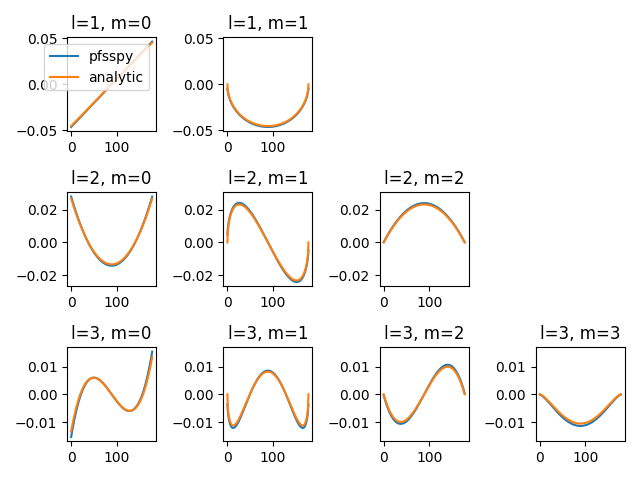Note
Click here to download the full example code
Spherical harmonic comparisons
Comparing analytical spherical harmonic solutions to PFSS output.
First, import required modules
import astropy.units as u
import matplotlib.pyplot as plt
import numpy as np
import sunpy.map
from matplotlib.gridspec import GridSpec
import pfsspy
from pfsspy import analytic
Setup some useful functions for testing
def theta_phi(nphi, ns):
# Return a theta, phi grid with a given numer of points
phi = np.linspace(0, 2 * np.pi, nphi)
s = np.linspace(-1, 1, ns)
s, phi = np.meshgrid(s, phi)
theta = np.arccos(s)
return theta * u.rad, phi * u.rad
def brss_pfsspy(nphi, ns, nrho, rss, l, m):
# Return the pfsspy solution for given input parameters
theta, phi = theta_phi(nphi, ns)
br_in = analytic.Br(l, m, rss)(1, theta, phi)
header = pfsspy.utils.carr_cea_wcs_header('2020-1-1', br_in.shape)
input_map = sunpy.map.Map((br_in.T, header))
pfss_input = pfsspy.Input(input_map, nrho, rss)
pfss_output = pfsspy.pfss(pfss_input)
return pfss_output.bc[0][:, :, -1].T
def brss_analytic(nphi, ns, rss, l, m):
# Return the analytic solution for given input parameters
theta, phi = theta_phi(nphi, ns)
return analytic.Br(l, m, rss)(rss, theta, phi).T
Compare the the pfsspy solution to the analytic solutions. Cuts are taken on the source surface at a constant phi value to do a 1D comparison.
ls = [1, 2, 3]
fig = plt.figure(tight_layout=True)
gs = GridSpec(len(ls), len(ls) + 1)
for i, l in enumerate(ls):
ax0 = fig.add_subplot(gs[i, 0])
axs = [fig.add_subplot(gs[i, j], sharey=ax0) for j in range(1, l + 1)]
axs = [ax0] + axs
for j, m in enumerate(list(range(l + 1))):
ax = axs[j]
nphi = 359
ns = 179
rss = 2.5
nrho = 20
br_pfsspy = brss_pfsspy(nphi, ns, nrho, rss, l, m)
br_actual = brss_analytic(nphi, ns, rss, l, m)
ax.plot(br_pfsspy[:, 180], label='pfsspy')
ax.plot(br_actual[:, 180], label='analytic')
ax.set_title(f'l={l}, m={m}')
if i == 0 and j == 0:
ax.legend()
plt.show()

Total running time of the script: ( 0 minutes 29.592 seconds)